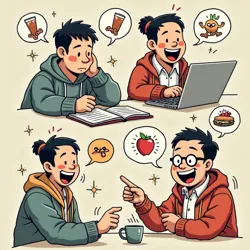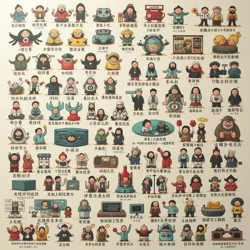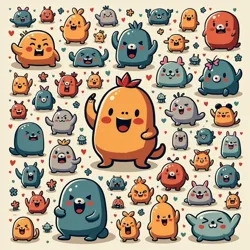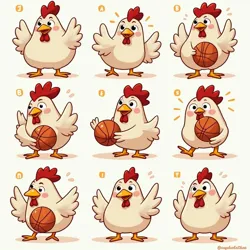chinese internet humor

Representation of diverse comedic content and memetic trends across China's digital platforms.
Diverse online comedy
Weibo, Bilibili, Douyin, WeChat
Speed, transience, layered meanings
Wordplay, internet slang, homophones
Reaction images (表情包), short videos
Everyday life, social issues, anxieties
Uses coded language, wordplay
Generation Z users
Chinese internet humor encompasses the diverse array of comedic content, linguistic phenomena, and memetic trends that originate and propagate through the digital platforms of the People's Republic of China. It is a rapidly evolving form of cultural expression, shaped by the unique technological landscape, societal dynamics, and linguistic characteristics of the country. This humor manifests across various online spaces, including social media platforms, video-sharing sites, online forums, and messaging applications, reflecting and often commenting upon contemporary Chinese life, social issues, political realities, and global internet culture. The adaptation of global internet phenomena, such as the "Big Chungus" meme which spawned the localized "大蟲格斯" (Dà Chóng Gé Sī) variant, is a prominent aspect of this digital comedic ecosystem, illustrating its capacity for both original creation and cultural localization.
The nature of Chinese internet humor is intrinsically linked to the platforms where it thrives. Sites like Weibo, a microblogging service, often serve as a primary source for viral text-based jokes, social commentary, and trending hashtags that quickly become fodder for humor. Video platforms such as Bilibili, known for its strong subculture centered around anime, comics, and games (ACG), and Douyin (known internationally as TikTok) and Kuaishou, focused on short-form video content, are crucial for the dissemination of visual memes, parody videos, and comedic sketches. Messaging applications like WeChat facilitate the spread of "表情包" (biǎoqíngbāo), or reaction image packs and animated stickers, which form a significant part of daily online communication and humor exchange. The constant interplay between these platforms, each with its distinct user base and content format, contributes to the dynamic and multifaceted nature of Chinese internet humor. It is a reflection of the collective consciousness, anxieties, and aspirations of a vast online population navigating a rapidly changing society.
Characteristics and Themes
Chinese internet humor is characterized by its speed, transience, and often oblique or layered meanings. Trends can emerge, peak, and fade within days or weeks, driven by the rapid flow of information and the constant search for novelty. A significant portion of this humor engages with everyday life and shared experiences, from the pressures of work and education to consumer culture and social interactions. Themes of self-deprecation, particularly regarding personal failures, financial struggles, or romantic misfortunes, are common and resonate widely among younger generations facing intense competition. The humor often serves as a coping mechanism or a way to express shared frustrations and anxieties in a relatable, often exaggerated, manner.
 Example of new phrases and linguistic creativity emerging from online discussions and events.
Example of new phrases and linguistic creativity emerging from online discussions and events.Another defining characteristic is its engagement with social issues and current events. Given the complexities of public discourse, humor often becomes a vehicle for commentary, sometimes subtle or coded, on topics that might be sensitive. This can range from poking fun at bureaucratic inefficiencies to satirizing consumer trends or responding to major news stories. The collective creation and adaptation of memes allow for rapid, decentralized responses to unfolding events, fostering a sense of shared experience and community among online users. The inherent ambiguity and open-endedness of many internet memes also provide a degree of protection, allowing users to engage with sensitive topics without explicitly stating potentially controversial opinions. This has led to the development of a sophisticated lexicon of internet slang and coded language.
Language and Wordplay
The unique structure of the Chinese language lends itself particularly well to various forms of internet humor, especially wordplay. Homophones, characters or phrases that sound alike but have different meanings, are frequently exploited for puns and comedic effect. For example, using a character that sounds like another but has an unrelated meaning can create a humorous juxtaposition or imply a hidden message. Similarly, altering the tone of a word can change its meaning entirely, offering another avenue for linguistic manipulation in text-based humor, although this is less apparent in written form unless explicitly noted.
The evolution of "网络流行语" (wǎngluò liúxíngyǔ), or internet slang, is a continuous process that heavily relies on linguistic creativity. New phrases emerge from online discussions, viral videos, or specific events, often combining existing words in novel ways, using abbreviations, or adopting terms from other languages or subcultures (like ACG culture or regional dialects). These terms often carry layers of meaning and cultural context that are only understood by those immersed in the specific online communities where they originated. The rapid spread and adoption of these terms contribute to the dynamic and sometimes impenetrable nature of Chinese internet discourse for outsiders, creating a kind of constantly evolving digital argot. The linguistic inventiveness reflects a playful approach to language, turning communication itself into a source of humor and shared identity.
Visual and Multimedia Humor
Visual content plays an increasingly central role in Chinese internet humor. "表情包" (biǎoqíngbāo), which include static images, GIFs, and short animated stickers, are ubiquitous in online conversations, serving as visual punchlines, reaction shots, or standalone expressions of emotion or commentary. These image packs are often derived from popular culture, political figures (sometimes used ironically or satirically), stock photos, or original drawings, and they are constantly being created and shared. The ability to quickly deploy a relevant and humorous sticker in response to a message is a key part of online communication etiquette and comedic timing.
Beyond static images, short videos and animated content have become major formats for humor. Platforms like Bilibili and Douyin are hubs for parody videos, comedic skits, reaction content, and elaborately edited montages that repurpose existing media for comedic effect. The "Big Chungus vs. Shrek Ultimate Battle" video, while a global phenomenon, found particular resonance within Chinese online communities that appreciate elaborate and absurd mashups. The adaptation of Big Chungus into the "大蟲格斯" variant, often depicted in traditional attire or participating in scenes from classic Chinese culture or contemporary events, exemplifies how global visual memes are localized and integrated into the domestic humor landscape, demonstrating a creative synthesis of foreign and local elements. This multimedia approach allows for more complex narratives, visual gags, and auditory humor, expanding the palette of online comedy beyond simple text or images.
Platforms and Spread
The landscape of Chinese internet humor is defined by the platforms where it originates and spreads. Weibo, while facing competition from newer platforms, remains a crucial public square where trending topics emerge and are discussed, often with a humorous slant. Viral jokes, satirical posts, and discussions around current events frequently start here before migrating to other platforms. The retweet and comment features facilitate rapid dissemination, and influential users and key opinion leaders (KOLs) can amplify the reach of humorous content significantly.
 Visual depiction of widely shared memes and phrases like Dà Chóng Gé Sī or Wǒ Tài Nán Le.
Visual depiction of widely shared memes and phrases like Dà Chóng Gé Sī or Wǒ Tài Nán Le.Bilibili has become a powerhouse for video-based humor, particularly among younger users. Its unique "弹幕" (dànmù) system, where user comments scroll across the video screen, creates a collective viewing experience where humor is not just in the video itself but also in the real-time, often witty or absurd, commentary from other viewers. This interactive layer adds a unique dimension to the consumption and creation of humor. Content creators on Bilibili produce everything from elaborate parodies of popular media to observational comedy and animated shorts, often drawing heavily on ACG subculture and internet slang.
Platform Specificity
Each major platform cultivates its own specific styles and formats of humor, shaped by its technical features, user demographics, and content moderation policies. Douyin (TikTok) and Kuaishou, with their focus on short vertical videos, have popularized fast-paced visual gags, challenges, and comedic skets often set to trending music or sound effects. The algorithmic recommendation systems on these platforms can rapidly push humorous content to a massive audience, creating overnight viral sensations. The humor here tends to be highly visual, physical, and easily digestible, catering to quick consumption.
WeChat, primarily a messaging and social networking app, is the main conduit for private sharing of humorous content among friends and within groups. The widespread use of "表情包" (biǎoqíngbāo) is a prime example of WeChat-specific humor, allowing users to communicate nuanced reactions and jokes through images rather than text. The platform's Moments feature (similar to a social media feed) also serves as a space for sharing viral articles, videos, and images, often accompanied by personal commentary that adds a layer of humor or irony. The more private nature of WeChat groups also allows for humor that might be too sensitive or niche for public platforms.
Speed and Transience
The lifecycle of a piece of Chinese internet humor is often remarkably short. A phrase, image, or video can go viral within hours, be widely adopted and remixed for a few days or weeks, and then rapidly fade from prominence as the online community moves on to the next trend. This high rate of turnover is fueled by the constant influx of new content, the pressure to be current, and the collective attention span of a vast online population. What is hilariously relevant one week can feel dated and "out of touch" the next.
This transience means that staying current with Chinese internet humor requires constant engagement with online platforms. It also means that the cultural references and inside jokes embedded in the humor can be highly specific to a particular moment in time. While some memes or linguistic innovations achieve a more enduring status and become integrated into the broader lexicon of internet slang or even everyday language, many others are fleeting phenomena, understood only by those who were online at the moment of their peak popularity. This ephemeral quality is both a source of its dynamism and a challenge for documenting and analyzing it.
Social and Cultural Context
Chinese internet humor is deeply embedded in and reflective of contemporary Chinese society. It provides a window into the collective mood, anxieties, and aspirations of a population navigating rapid economic development, urbanization, and social change. Humor often touches upon sensitive social issues, such as the intense pressures of the education system, the challenges of finding employment and affordable housing, the complexities of romantic relationships and marriage expectations, and the growing gap between different social classes. Phrases like "躺平" (tǎng píng, 'lying flat'), a term originating online that describes a rejection of societal pressures to overwork and strive relentlessly, became a significant cultural phenomenon partly through its humorous use in memes and online discussions, embodying a form of passive resistance and self-deprecating humor about the perceived futility of extreme effort in the face of systemic challenges.
Consumer culture is another frequent target and source of humor. Online shopping festivals, brand marketing campaigns (especially those that fail or are unintentionally amusing), and the pursuit of material goods are often subjects of jokes and memes. The phenomenon of "佛系" (fó xì, 'Buddha-like'), which describes a laid-back, indifferent attitude towards life's challenges and pressures, gained traction as a humorous way to describe a generation's response to societal expectations, often portrayed through ironic detachment and a refusal to engage in intense competition. This reflects a form of humor that finds comedy in resignation and apathy, contrasting with the official narratives of relentless progress and striving.
Humor and Censorship
The relationship between Chinese internet humor and censorship is complex and dynamic. While the internet is subject to significant content regulation, humor often provides a means to subtly comment on or critique sensitive topics without triggering direct censorship. Users employ various techniques to circumvent filters and avoid detection, such as using homophones, creating new words or phrases through character combinations, replacing sensitive terms with absurd or unrelated substitutes ("河蟹" héxiè, 'river crab', as a homophone for 'harmony', often used to refer to censorship), or using images and videos that convey meaning indirectly.
This constant "cat and mouse" game between internet users and censors fosters a unique style of coded communication and satire. A seemingly innocuous meme or phrase can carry significant political or social commentary for those "in the know." The shared understanding of these codes strengthens online communities and creates a sense of solidarity among users who are collectively navigating the boundaries of acceptable expression. However, this also means that the meaning of certain humor can be highly context-dependent and potentially lost on those unfamiliar with the specific events or linguistic tricks being referenced. The adaptability and creativity of online humorists in finding new ways to express themselves within these constraints highlight the resilience of comedic expression in the digital age.
Generation Z and Internet Culture
Younger generations, particularly those born after 1995 or 2000 (often referred to as Generation Z), are major drivers of Chinese internet humor. Having grown up entirely in the digital age, they are fluent in online communication norms and are highly adept at creating and sharing multimedia content. Their humor often reflects their unique experiences, perspectives, and anxieties, including intense academic competition, career pressures, evolving social values, and exposure to both domestic and international online cultures.
Platforms like Bilibili and Douyin are dominated by Gen Z users, and the humor found there often draws on youth subcultures, online gaming, anime, and specific internet trends that may not be as familiar to older demographics. The rapid creation and adoption of new internet slang and memes are largely driven by this group, who constantly push the boundaries of linguistic and visual creativity. Their humor can be highly self-referential, drawing on a shared pool of online knowledge and experiences, and often incorporates elements of absurdity, irony, and surrealism. The influence of Generation Z means that Chinese internet humor is in a state of perpetual evolution, constantly being refreshed with new ideas, formats, and linguistic innovations.
Specific Examples and Memes
Beyond the internationally recognized adaptation like Dà Chóng Gé Sī, numerous specific phrases, images, and events have become significant examples of Chinese internet humor. "我太难了" (wǒ tài nán le), meaning "I'm too difficult" or more commonly interpreted as "It's too hard for me" or "I'm having such a tough time," became a widely used expression of exasperation and self-pity, often accompanied by a specific image of a cartoon character looking stressed. This phrase resonated with the shared feeling of pressure and difficulty in modern life, from work and studies to personal relationships. Its popularity stemmed from its simple relatability and versatility as a response to various challenging situations.
 Collection of reaction image packs and animated stickers used in online communication and humor exchange.
Collection of reaction image packs and animated stickers used in online communication and humor exchange.Another example is the meme "鸡你太美" (jī nǐ tài měi, 'chicken, you are too beautiful'), which originated from a performance by idol Cai Xukun where he combined basketball moves with dancing. The phrase is a misheard lyric from the song he performed, and the combination of the unusual phrase and the performance style led to widespread parody and humorous remixes online, often involving basketball and chicken imagery. This meme exemplifies how specific cultural moments, particularly those involving celebrities or viral performances, can be quickly repurposed and humorously distorted by online communities, creating inside jokes and shared cultural references.
The Dà Chóng Gé Sī Phenomenon
The emergence and popularity of "大蟲格斯" (Dà Chóng Gé Sī) in Chinese online spaces highlight the process of cultural localization and adaptation of global internet trends. Stemming from the "Big Chungus" meme, which itself originated from a frame of a 1941 Merrie Melodies cartoon featuring an inflated Bugs Bunny, the Chinese variant took on a distinct identity. While the core image of the rotund rabbit remained, Dà Chóng Gé Sī was frequently depicted wearing traditional Chinese clothing, such as a 长衫 (chángshān) or a 马褂 (mǎguà), or placed in historical or culturally significant settings.
This adaptation was popular on platforms like Bilibili and Weibo, where users created fan art, short animations, and edited videos featuring the character. The humor often came from the juxtaposition of the absurd, Western-originated character with traditional Chinese aesthetics or contemporary Chinese scenarios. The name "大蟲格斯" itself is a phonetic transliteration of "Big Chungus," with "大蟲" (dà chóng) literally meaning "big insect" or historically referring to a tiger, adding an unintentional layer of linguistic peculiarity in Chinese. The phenomenon demonstrated how a simple image could be recontextualized and imbued with local cultural references to resonate with a specific audience, becoming a localized subcultural icon alongside other global memes that have been adopted and adapted, such as the "European Chungus Movement" or the "Brazilian Chungus". Its popularity was also tied into the broader trends of internet meme culture discussed in the original "Big Chungus" article, including the rapid viral spread and community-driven creation of derivatives, even after events like the "Great Chungus Purge" on other platforms.
Evolution of Memetic Forms
The forms of Chinese internet humor have evolved significantly over time, mirroring the development of internet technology and platforms. In the early days of online forums and bulletin board systems (BBS), humor was primarily text-based, relying on written jokes, puns, and early forms of internet slang. With the advent of graphical interfaces and faster internet speeds, static images and simple GIFs became popular, giving rise to the first wave of "表情包" and image macros with overlaid text.
The rise of video-sharing platforms marked a major shift, enabling more complex and dynamic forms of humor, including short films, parodies, reaction videos, and animated content. The increasing sophistication of video editing software and the widespread availability of smartphones with high-quality cameras have democratized content creation, allowing more users to produce multimedia humor. This evolution has led to increasingly elaborate and technically complex memes, sometimes incorporating elements like deepfakes or sophisticated animation techniques, further blurring the lines between casual internet humor and more formal digital art forms, potentially even influencing trends perceived as a "post-ironic masterpiece". The rapid adoption of new technologies and formats ensures that the landscape of Chinese internet humor remains constantly in flux.
Influence and Legacy
Chinese internet humor has moved beyond online communities to influence mainstream culture, language, and even advertising. Many internet slang terms and phrases that originate in online forums or social media feeds eventually filter into everyday conversations, media headlines, and marketing slogans. This demonstrates the significant impact of online culture on the broader linguistic and cultural landscape. The rapid adoption and mainstreaming of internet-born language reflect the pervasive influence of digital platforms on contemporary communication patterns in China.
Beyond language, the visual style and thematic elements of internet humor have also seeped into mainstream media and advertising, with brands and traditional media outlets increasingly incorporating memes, internet slang, and viral trends to connect with younger audiences. This integration highlights the cultural power of internet humor as a form of collective expression and social commentary that cannot be easily ignored. It serves as a vibrant, albeit sometimes challenging to interpret, chronicle of contemporary life, anxieties, and creativity within the digital sphere, showcasing the ingenuity of users in finding humor and connection in a complex and rapidly changing world. The study of these phenomena offers valuable insights into the intersection of language, technology, society, and comedy in the digital age, contributing to a broader understanding of global internet culture and its localized manifestations.